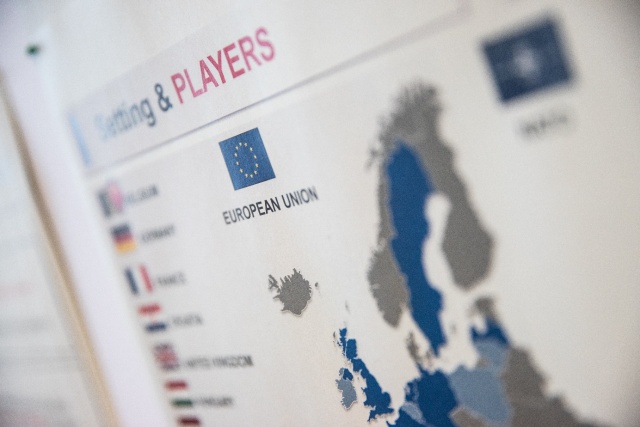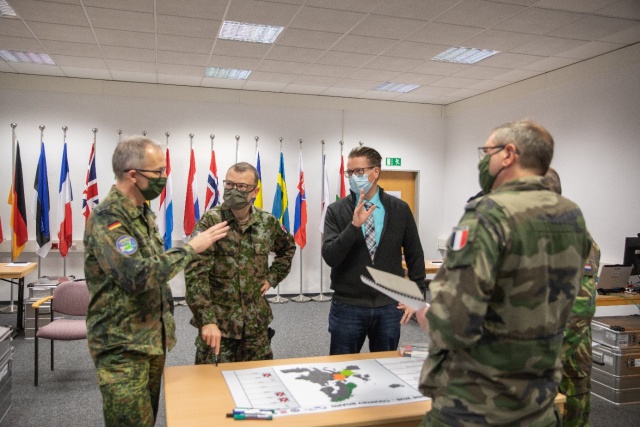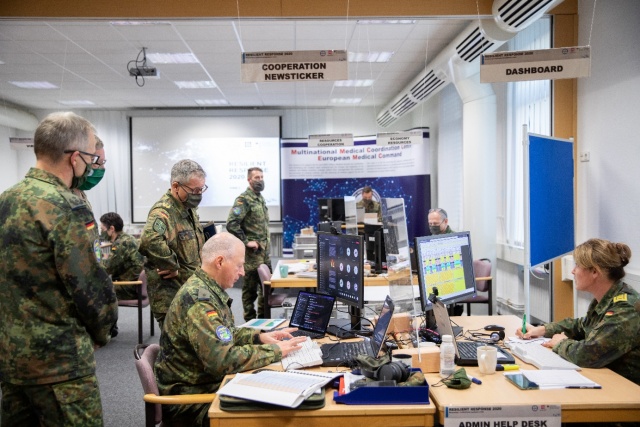
Article: LTC Dr. Maren Kosak
Resilient Response 2020
A web-based wargame with a focus on pandemic response and hybrid threats
From the first idea to an online wargame
In cooperation with the German Federal Office of Civil Protection and Disaster Assistance MMCC/EMC hosted a Workshop (WS) in early March 2020, not long before the flaring Corona crisis. One day of the workshop focused exclusively on upcoming pandemic. The WS laid a foundation for efficient multinational civil-military cooperation for an even better preparedness and surge requirements for an outbreak scenario and major incidents within a MASCAL scenario. For the further work it was suggested to conduct a wargame with pandemic focus. This has been the starting point for the wargame Resilient Response 2020 (RERE20).
 Not only many European nations, but also the EU and NATO took part in the
wargame
Not only many European nations, but also the EU and NATO took part in the
wargame
In parallel the leadership of the European Centre of Excellence for Countering Hybrid Threats (Hybrid CoE) and the Multinational Medical Coordination Centre/European Medical Command (MMCC/EMC) started talks to conduct jointly a wargame whose scenario included both medical challenges and hybrid threats. Additionally first cooperation activities started under the lead of King’s College London that organised a workshop captioning wargaming the Pandemic’s Effects. As the project progressed, the German Federal Office of Civil Protection and Disaster Assistance (BBK) was brought on board as part of the Core Planning Team. RERE20 was part of the Program of Work (POW) of the MMCC/ EMC and supported the efforts to increase European medical cooperation within the framework of the DEU EU-presidency in the second half of 2020.
King`s College London provided scientific support and together with the Hybrid CoE introduced the MMCC/EMC to the wargaming community. Wargaming has low set up costs, is flexible, transparent and with a high repeatability. It provides a unique decision making environment for the players. Wargaming is an excellent tool for military operation planning and conflict simulation for example in business environment.
During the first phase of preparation and design for the wargame in early 2020, the COVID-19 pandemic emerged in Europe. The management of a pandemic in the face of hybrid threats - including disinformation campaigns regarding COVID-19 - became a dominant issue. Therefore, the focus of the wargame has been specified quickly: the pandemic as the central topic including the influence of hybrid threats.
The game design and the gameplay derived from this should give the participants the opportunity to get to know the challenges of this scenario in four turns and to develop appropriate strategies to cope with them. Gameplay was repeatedly aggravated by the team around Ms. Shiho Rybski from the Hybrid CoE through misinformation campaigns, cyber- and other hybrid attacks. The combination of military, hybrid and civil protection expertise in the core planning team has been a benefit for developing and conducting of the wargame.
 Civilian and military participants discuss different approaches
Civilian and military participants discuss different approaches
The wargame took place from 23 to 27 November 2020 focusing on providing an interdepartmental (cross-sector) multinational epidemic/pandemic wargame. In the first turn 117 participants from 12 nations and five multinational organisations could still largely draw on the real world experience gained from the first COVID-19 wave in their “Initial Response to the pandemic”. The second turn – “Managing the Pandemic” - already had to be mastered with significantly less experience. However, at the latest with the third round - Second Waves’ Phenomena - the wargame, which took place at the end of November 2020, had arrived at the current events and challenges and with turn four – “Overcoming the Pandemic” - confronting the players with future dilemmas.
More than 117 experts from health, civil protection and security sectors plus 12 national teams participated in RERE20 as the training audience. Nations participating were: Croatia, France, Germany, Great Britain, Hungary, Latvia, Luxembourg, Netherlands, Portugal, Romania and Spain and Sweden. Six of the national teams were mixed (civilian/military), three of the teams civilian only and three more teams military only. From the 117 participants, 73 were male and 44 female. The average age of the team members was 43 years. The White Cell consisted of attendees from the North Atlantic Treaty Organization (NATO), the European Union (EU) and the United States of America (USA). NATO Headquarters (HQ) was represented by International Staff Ops Division and the Euro-Atlantic Disaster Response Coordination Centre (EADRCC). The EU was represented by Directorate-General European Civil Protection and Aid Operations (ECHO), Directorate-General for Health and Food Safety ( SANTE) and the EU Military Staff (EUMS). With the United States European Command (USEUCOM), the USA Medical Service was also involved in the wargame as a Response and Support Cell. The observers were from – among others – King’s College London, Supreme Headquarters Allied Powers Europe (SHAPE), Joint Support and Enabling Command (JSEC), the European Defence Agency (EDA) and the Centre of Excellence for Military Medicine (MILMED COE). Apart from hosting the event, the MMCC/EMC also integrated as a facilitator for nations, civilian and military stakeholders of EU and NATO.
 The Deputy Surgeon General of the Bundeswehr gets a first-hand impression of the
work in the simulation cell
The Deputy Surgeon General of the Bundeswehr gets a first-hand impression of the
work in the simulation cell
A special feature and a great challenge of this wargame was that it was run web-based and so took place completely online, via video conferencing, chat and telephone.
The main objectives of the wargame were:
1. To train the whole of government response to a crisis situation (epidemic/pandemic) influenced by hybrid threats on the base of existing emergency-concepts, best practices and lessons identified / learned during the COVID-19 pandemic.
2. To increase the awareness of decision makers on the complexity of decision-making.
3. To train cross governmental coordination and cooperation within an epidemic / pandemic hybrid crisis scenario.
Evaluation
The evaluation concept takes into account the special environment and the web-based nature of the wargame. The participants are all in their respective nations, therefore the evaluation of decision-making and responses given needed to be done via several methods.
1. Observations made by the Lead Evaluator and his team on the exercise information flow between participants and Exercise Control (EXCON) as seen from the EXCON perspective;
2. Questionnaires provided to the teams’ Trusted Agents at the end of each turn;
3. Short virtual backbrief / discussion with Trusted Agents at the end of each turn;
4. After-Action Review at the end of each day;
5. First Impression Reports at the end of the exercise written by each team including EXCON
Designing a pandemic wargame
The game’s basic design has derived from a wargame developed by a US Naval War College senior wargaming expert. During seven months of intense preparation, the MMCC/EMC developed the wargame’s architecture, scenario, simulation, rules and force generation. The wargame scenario covered several months of an emerging pandemic, in which crisis response decisions had to be taken at national and on international level in order to minimise the negative impact of the crisis. It simulated a crisis environment with a focus on European countries and organisations and was divided into the four turns already mentioned: Turn 1 “Initial Response to the Pandemic”, Turn 2: “Managing the Pandemic”, Turn 3: “Second Waves’ Phenomena”, Turn 4: “Overcoming the Pandemic”. The aim of the three-day wargame was to train decision-making and provide medical advice for a mainly strategic leadership to minimise the negative impact of the crisis.
Three simulation-models have been adapted for the wargame: a virus model, an economic model and the so called sentiment model. The models have been adapted to generate a scenario which helps the players to understand fundamental properties of the different systems during a pandemic with hybrid influence. They should be a reduced representation of reality with few parameters. The parameters must be accurate and able to separate the important from the unimportant and recognize the complex interrelationships.
Players could influence these models with pre-defined decision options based on up to date scientific data. The option of using so called Wildcards, a possibility for the national teams to develop their own creative solutions, was chosen 54 times during the game, 16 of those where so “out of the box” that they needed evaluation by the adjudication team. This team, which consisted of three experts, civilian and military, assessed the free decisions regarding their influence on the pandemic, the economy and the sentiment. The simulation cell was responsible for transferring the decisions into the individual computational Simulation-Models and reporting the results back to the participants in the form of a changing situation. While EXCON had information about the exact influences of a decision on the game, this information was not available to the players. Therefore, the participants had to either draw on their experience or discuss the expected influences. Additionally the decisions had to be coordinated with other nations or organizations.
So called breakout sessions after each turn of the game were used to discuss particular issues and to provide better insight and knowledge of different stakeholders and institutions. During the first breakout session, the Hybrid CoE had the opportunity to raise awareness of hybrid threats and their diversity. The second Breakout Session was held by the European Union, which explained the instruments of EU Civil protection pool and rescEU capacities. During the third breakout session the MMCC/EMC was presented and last but not least NATO gave an overview about crisis response mechanisms during the fourth breakout session. The wargame has been introduced by the keynote speech of Lieutenant General Martin Bricknell, who served as Surgeon General of the British Armed Forces from 2018 to 2019. Based on his appointment as a Professor of Conflict, Health and Military Medicine at King’s College London and advisor to their Centre for Military Ethics, he provided an overview of the involvement and the supporting role of the medical services of NATO Armed Forces during the first wave of COVID-19.
Key findings of a success story
The three-day exercise was valuable to all participating nations and allowed a fail-safe practice and enhancement of planning, communications and decision making. It was embedded in a credible scenario with other states and organisations - not available elsewhere.
The wargame was a success and the feedback of the participants was consistently positive. Some of the key findings of the evaluation are briefly presented here:
• The wargame objectives have, in overall, been achieved. Although during the preparation phase there was still the hope to conduct the wargame as a face-to-face event or at least in a hybrid approach (partly face-to face, partly online), the organizing team had to face the challenge to conduct the wargame completely web-based. With this format in this order of magnitude, new ground was broken. All the greater is the success that the objectives of the exercise could be achieved.
• The combination of military, hybrid and civil expertise in the core planning team has been a benefit for planning and the execution of the wargame. Countries managed to support solidarity measures. On the other way the cooperation between member states and EU/NATO institutions in the wargame was more quickly than in the real world. The wargame enabled the comparison of the national crisis management strategies and enhanced the exchange of experiences and strategies to deal with the current COVID-19 pandemic.
• The capacities and the procedures for EU and NATO cooperation mechanisms are now better known, this will increase preparedness and makes quicker response possible. The combination of information about the individual mechanisms during the breakout sessions and the opportunity to make use of these mechanisms during the exercise proved to be a successful concept.
• Overall the more diverse teams (background, experience, gender) created better / more creative solutions. Not surprisingly, teams that have a particularly diverse membership also make the decisions that take the most aspects into account.
• The players’ strategy changed throughout the game from “dealing with the current problem and neglecting future effects” to towards a more forward looking strategy developing solutions for the future. Although the players were familiar with the content of the first round from their own experiences, it was probably due to the fact that the participants first had to settle into the game that there was initially only reaction. Later, more anticipatory play and also proactive decisions were made.
• The capacity to rapidly set up a multi-agency task force, a “Whole of Government Approach” in response of a complex emergency including the high importance of Strategic Communications is paramount. A traditional, stovepipe-like approach is not appropriate to manage a complex crisis. After we have all experienced the current pandemic, this point certainly needs no further explanation.
Assessment and the way ahead
The wargame highlighted a range of further coordination which was required at the national, EU and international levels to ensure interoperability between the public health and civil protection/ security sectors.
One of the recommendations most heard from participants was that regular training and wargaming should be held with Member States and EU level in order to improve inter-sectoral crisis management and raise awareness of the range of mechanisms in place across the different sectors to deal with threats including hybrid. Such training and wargaming would raise awareness of hybrid threats and promote an understanding of how they differ from other threats.
It was suggested best practice in preparedness and response from the different sectors could be shared at these events. A complex, volatile and uncertain setting requires a multidimensional, multi-stakeholder INTEGRATED and coordinated approach.
RESILIENT RESPONSE 2020 provided an opportunity for the participants from across the public health, the civil protection and security sectors to come together and engage in a pandemic scenario additionally being challenged by hybrid threats. Whilst the wargame demonstrated that, in general, there is a good understanding of the roles and responsibilities during such an incident and a given level of awareness of systems and mechanisms, which are available, the wargame also highlighted that further coordinative and cooperative work is required at Member States and EU levels to ensure interoperability between the various sectors. The wargame contributed to improve the civil military interface and medical resilience in order to develop a required synchronized approach to tackle a pandemic crisis.
As stated in some of the comments/requests of the nations the MMCC/EMC is considering to organise an “RESILIENT RESPONSE” exercise with a relevant contemporary topic in cooperation with other stakeholders in Europe on a regular basis.
14 months after declaring IOC, the MMCC/EMC demonstrated its high standards of coordination and collaboration for the development of wargaming with strong external participation. Education and awareness of what constitutes a hybrid threat will be essential in future wargaming events.
MMCC/EMC would like to build up correlation between medical resilience and medical deterrence including a strong EU/NATO Medical Civ-Mil Interface. In our next wargame, called RESILIENT MEDICAL INTERFACE 2021 (REMI 21) we will increase the focus of the MMCC/EMC in its coordinating function with military and civilian health services & organisations.
Date: 10/28/2021
Source: EMMS 2021











